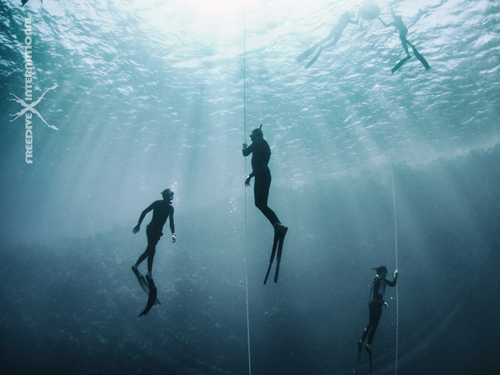When you hold your breath, O2 is still converted to CO2, but the latter has nowhere to go. It re-circulates in your veins, acidifying your blood and telling your body to breathe, first through a warm sensation in your lungs, and eventually in the form of strong spasms of your diaphragm, commonly called “contractions”. Luckily for us, it is easy to train physically and mentally to cope with those signals for a while.
Dynamic Apnea:
Learning freediving skills in the sea before the pool has never been a good idea. Confined water or pool training is safe, controlled, warm and familiar. At Freedive Dahab you will learn freediving techniques first in the shallow water then try it in the ocean. In this training you will learn more about weighting, finning, streamlining and speed. You will also learn and practice warm up routine and safety skills. Weighting becomes more important the longer you want to stay at the same depth: this is why it is vital for the Dynamic Apnea, When you find your neutral buoyancy for dynamic, your body stays in mid-water without floating up or sinking down. Streamlining is also an important part of dynamic apnea, but so is relaxation. The key is to find the balance between the two. It’s good to train with a tight streamline in order to increase shoulder flexibility, then back it off slightly when you go for maximum performance. When it comes to speed, a part of it depends on if you are a person with primarily a good breath hold time, or primarily good fitness. Either you treat dynamic as a “moving static” or you use your muscles more to move “faster” to cover more distance in shorter time. But remember, “fast” in freediving is still in the upper range of slow, compare with other water sports. During this freediving course you will make your technique sharper and understand how your body works to max up your performances.
Depth Training:
Freediving legend Umberto Pelizzari said:
“The scuba diver dives to look around. The free diver dives to look inside”
Freediving is a form of meditation or self-discovery for many freedivers, diving deeper not only into the ocean but also into themselves.
The more you train, the more experience and comfort you gain, the deeper you will go. Many beginner freedivers did not believe it was possible for them to reach 15-20 meter unless they were super humans. But most beginner freedivers can do it already after their beginner course and maybe just a few training sessions. The same will happen during your Advanced Freediving Course. Freediving to 30m isn’t much harder than 20m when you have the right techniques. Even though we are not able to breathe underwater, out bodies are built to adapt to breath hold in a fantastic way, starting to utilize the O2 available in the most efficient way possible. Your freediving training in Dahab will provide you techniques to enhance this even further, extending your breath hold time and provide you with a unique way to experience the aquatic world. Freediving is one of the fastest-growing water-sports in the world. The better you become at it, the more you will be able to explore the oceans around the world.
SCHEDULE:
DAY 1: Starting at about 9am with some review about breathing and breathe-up techniques and theory about different training methods applicable to both confined and open water training, and dry training. We follow with a static breath-hold session and debriefing. After the lunch break we do the first OW session, working mainly on buoyancy and free falling.
DAY 2: Theory followed by CO2 tables dynamic in confined water, and after lunch break we head to the second OW session, to keep practicing free falling and learn Frenzel equalization.
DAY 3: Two OW sessions, one in the morning and one in the afternoon with theory and exam in the break. At the end of the day debriefing with wrap-up and celebration photos for our Facebook Page!

